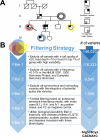Identification and Functional Characterization of a Novel CACNA1C-Mediated Cardiac Disorder Characterized by Prolonged QT Intervals With Hypertrophic Cardiomyopathy, Congenital Heart Defects, and Sudden Cardiac Death
- PMID: 26253506
- PMCID: PMC5094060
- DOI: 10.1161/CIRCEP.115.002745
Identification and Functional Characterization of a Novel CACNA1C-Mediated Cardiac Disorder Characterized by Prolonged QT Intervals With Hypertrophic Cardiomyopathy, Congenital Heart Defects, and Sudden Cardiac Death
Abstract
Background: A portion of sudden cardiac deaths can be attributed to structural heart diseases, such as hypertrophic cardiomyopathy (HCM) or cardiac channelopathies such as long-QT syndrome (LQTS); however, the underlying molecular mechanisms are distinct. Here, we identify a novel CACNA1C missense mutation with mixed loss-of-function/gain-of-function responsible for a complex phenotype of LQTS, HCM, sudden cardiac death, and congenital heart defects.
Methods and results: Whole exome sequencing in combination with Ingenuity variant analysis was completed on 3 affected individuals and 1 unaffected individual from a large pedigree with concomitant LQTS, HCM, and congenital heart defects and identified a novel CACNA1C mutation, p.Arg518Cys, as the most likely candidate mutation. Mutational analysis of exon 12 of CACNA1C was completed on 5 additional patients with a similar phenotype of LQTS plus a personal or family history of HCM-like phenotypes and identified 2 additional pedigrees with mutations at the same position, p.Arg518Cys/His. Whole cell patch clamp technique was used to assess the electrophysiological effects of the identified mutations in CaV1.2 and revealed a complex phenotype, including loss of current density and inactivation in combination with increased window and late current.
Conclusions: Through whole exome sequencing and expanded cohort screening, we identified a novel genetic substrate p.Arg518Cys/His-CACNA1C, in patients with a complex phenotype including LQTS, HCM, and congenital heart defects annotated as cardiac-only Timothy syndrome. Our electrophysiological studies, identification of mutations at the same amino acid position in multiple pedigrees, and cosegregation with disease in these pedigrees provide evidence that p.Arg518Cys/His is the pathogenic substrate for the observed phenotype.
Keywords: Timothy syndrome; calcium channels, L-type; cardiomyopathy, hypertrophic; death, sudden, cardiac; genetics; long QT syndrome.
© 2015 American Heart Association, Inc.
Figures






References
-
- Go AS, Mozaffarian D, Roger VL, Benjamin EJ, Berry JD, Blaha MJ, Dai S, Ford ES, Fox CS, Franco S, Fullerton HJ, Gillespie C, Hailpern SM, Heit JA, Howard VJ, Huffman MD, Judd SE, Kissela BM, Kittner SJ, Lackland DT, Lichtman JH, Lisabeth LD, Mackey RH, Magid DJ, Marcus GM, Marelli A, Matchar DB, McGuire DK, Mohler ER, 3rd, Moy CS, Mussolino ME, Neumar RW, Nichol G, Pandey DK, Paynter NP, Reeves MJ, Sorlie PD, Stein J, Towfighi A, Turan TN, Virani SS, Wong ND, Woo D, Turner MB. Executive summary: Heart disease and stroke statistics--2014 update: A report from the American Heart Association. Circulation. 2014;129:399–410. - PubMed
-
- Maron BJ. Hypertrophic cardiomyopathy: a systematic review. JAMA. 2002;287:1308–1320. - PubMed
-
- Maron BJ, Towbin JA, Thiene G, Antzelevitch C, Corrado D, Arnett D, Moss AJ, Seidman CE, Young JB. Contemporary definitions and classification of the cardiomyopathies: An American Heart Association scientific statement from the Council on Clinical Cardiology, Heart Failure and Transplantation Committee; Quality of Care and Outcomes Research and Functional Genomics and Translational Biology Interdisciplinary Working Groups; and Council on Epidemiology and Prevention. Circulation. 2006;113:1807–1816. - PubMed
Publication types
MeSH terms
Supplementary concepts
Grants and funding
LinkOut - more resources
Full Text Sources
Molecular Biology Databases

